![]()
![]()
![]()
Use LEFT and RIGHT arrow keys to navigate between flashcards;
Use UP and DOWN arrow keys to flip the card;
H to show hint;
A reads text to speech;
18 Cards in this Set
- Front
- Back
- 3rd side (hint)
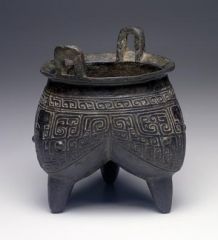
1) What is this item?
2) What time and dynasty is it from? 3) What is it made of? 4) What was it used for? |

1) a tripod ritual vessel called a Li
2) from the Shang Dynasty, 13th C BC 3) bronze cast using a clay mold 4) it was used to present ritual offerings (a meal) in a tomb to honor an ancestor |
It is likely a descendent of a Neolithic terracotta vessel called a gui. Guis were used to cook over a fire.
|
|

1) What is this item?
2) What Dynasty/ time is it from? 3) That is it made of? 4) How was it used? |
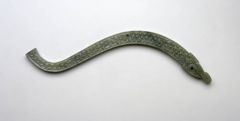
1) a pendant in the form of a dragon
2) from the Late Eastern Chou (Zhou) Dynasty, 475b.c.-221 b.c. 3) carved from a very thin piece of jade (one quarter inch thick) very hard to carve, ancient techniques involved cutting very thin stone slabs using a cord and an abrasive 4)likely that this pendant would have been put on the body of the deceased in a burial. it could have also been worn as a protective device |
Dragons, phoenix, and tiger motifs were very popular during the Warring States period. this could have been used for rituals for the living as well as in burials. This dragon's body is simplified to near abstraction
|
|
|
1) This is a sculpture of a dancer with long sleves that stands 20" tall. Her features reflect the ideal of beauty in the Han period-high forehead,delicate ears,refined facial features, tiny mouth.
2) Western Han Dynasty, 2nd century, B.C. 3) earthenware (clay) shaped by means of a mold, allowed to dry and fired then painted (only traces of paint remain) 4) She was used in a tomb and was intended to enrich the afterlife. Clay figures served as substitutes for the living humans who had been enclosed whithin tombs in earlier times. |
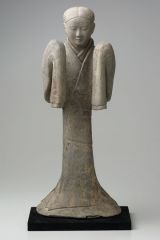
1) What is this?
2) What Dynasty/ time is it from? 3) What is it made of? 4) How was it used? |
Music and dance were important aspects of life in the imperial courts. In addition to serving as entertainment, dance and music were intended to function as a moral force in society. Confucius believed that certain styles of dance could promote harmony and joy among the people.
|
|
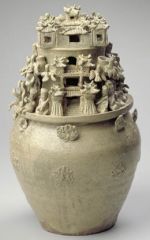
1) What is this?
2) What Dynasty/ time is it from? 3) What is it made of? 4) How was it used? |

1)a large funerary jar called a Spirit Jar (hun ping) that is topped with a model of a four story palace.The buildings are surrounded by small figures and birds.
2) Western Chin (Jin) Dynasty, late 3rd century 3) stoneware called Yueh Ware. The jar form was thrown on a wheel unlike the pottery from earlier periods and has pressed on decorations added to it . it is glazed with an olive green glaze unique to the period. 4)This vessel was created to house the soul of the departed. The palace would have been seen as an ideal home. The artist left the door of the palace open so that soul could enter. |
Spirit jars are unique to the period of disunity that followed the Han period. Earlier tombs do not contain anything similar in form or decoration.
|
|

1) What is this?
2) What Dynasty/ time is it from? 3) What is it made of? 4) How was it used? |

1) this is a scroll painting called "Exalted Gathering in the Green Woods" painted by Huang Ts'un-wu
4) Wealthy patrons aspired to own many such scrolls of both horizontal and vertical formats which could be used to stimulate discussion when shared by visitors. The painting is a scene of scholars- members of the literati who were highly trained in the teachings of Confucius and his followers. Calligraphy was done by Tung Ch'i-Ch'ang. 2) Ming Dynasty, Wanli Period, c 1620 3) This is a scroll that is ink on paper. It uses a horizontal format and is intended to be held in hand and unrolled section by section for viewing among friends. |
Artists of the Ming period looked back to examples of great schools of painting that emerged during the Song period. This is a collaborative work.
|
|
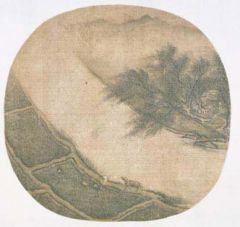
1) What is this?
2) What Dynasty/ time is it from? 3) What is it made of? 4) How was it used? |

1) A silk fan with a landscape showing a "Boy Leading an Ox Along the Farm Path." It is luxury item for the elite. Painting shows the harmonious relationship between humans and nature. Has a dramatic birds-eye view.
2) Southern Sung (Song) Dynasty, late 13th Century 3) ink and colors (earth pigments) on silk. Inscribed by Liu Songnian, could possibly be the artist 4).This image illustrates Daoist ideal as well as the hierarchical order that appealed to Confucian thinkers. ` |
Composition is divided into three primary zones shich are placed diaggonal to the picture plane. bottom- man leading ox through field (lines are rice paddy irrigation), middle- smooth river, top-range of mountains
|
|
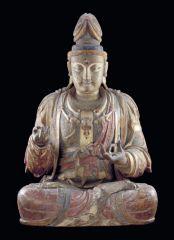
1) What is this?
2) What Dynasty/ time is it from? 3) What is it made of? 4) How was it used? |

1) a sculpture of the Buddhist Bodhisattva Kuan-yin.
3) Carved out of wood in segments and joined together. Wood is covered in gesso (primer) then painted with mineral pigments, gold, glass eyes 4) This statue would be placed in a temple or shrine. A bodhisattva is a buddhist follower who has achieved enlightenment but has chosen to help guide others instead of entering nirvana. Kuan-yin is is a popular bodhisattva who represents the spirit 2) Sung (Song) Dynasty, late 11th Century of mercy and compassion. |
Song dynasty sculpture is known for its great naturalism. The complex folds of Kuan-yin's robes give this figure a sense of liveliness, even though the pose itself is static (still). The calm and benevolent facial expression could invoke piety on the viewer.
|
|
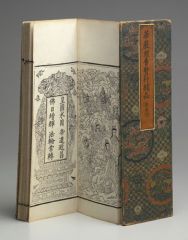
1) What is this?
2) What Dynasty/ time is it from? 3) What is it made of? 4) How was it used? |

1) the Book of Sudhana from the Garland Sutra (Hua-yan Ching Pu-hsien Hsing-yuan Pin) a small compact book about a young Indian boy named Sudhana who searching for enlightenment, receives the assistance of the bodhisattva Samantabhadra who teaches him the 10 compassionate vows.
2) Ming Dynasty, Late Sixteenth Century 3) woodblock print on paper, paper is folded accordion style 4) because of the printing process more copies could be made of the sutras and they could be distributed more widely |
front image depicts the Buddha surrounded by his followers. because this image is carved onto a woodblock the emphasis is on line. In contrast to the artist painting with water color or ink
|
|
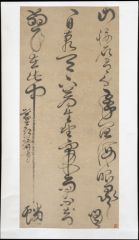
1) What is this?
2) What Dynasty/ time is it from? 3) What is it made of? 4) How was it used? |

1) a work of calligraphy on a hanging scroll titled "Verse in Cursive Script" it reads- " The mountain's rocky girth has endured a thousand years, A day has never passed without dragons and oceans, Beneath heaven a verdant earth awaits benevolence, Not knowing if clouds will settle here."
2) Ming dynasty, c.1410 by calligrapher Chieh Chin (1369-1415) 3) ink on paper 4) the basic function of writing is to communicate ideas through text, calligraphy is intended to have a aesthetic appeal (to have beauty) that goes beyond the significance of the words themselves. |
Calligraphy is a form of expression that can reveal a writers personality and form of self-cultivation. In addition, the appreciation of calligraphy is an intellectual activity.
|
|
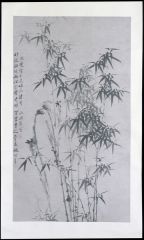
1) What is this?
2) What Dynasty/ time is it from? 3) What is it made of? 4) How was it used? |

1) a poetic painting called " Bamboo and Rocks" accompanied by text in the form of a vertical scroll
2) Ch'ing (Qing) Dynasty, c 1760 by Cheng Hsieh (1693-1765) 3 )Ink on paper 4) Cheng Hsieh was a literati class member who was a painter, a poet, and a calligrapher. He was a member of a group of painters known as the "Eight Eccentrics of Yangzhou" Not a formal school, but a loosely connected group of artists who shared ideas about art. |
Cheng Hsieh painted many variations on bamboo throughout his life. Bamboo was a popular subject because it is a beautiful, native plant of China. In addition bamboo came to represent qualities that humans strive for: firmness and strength as well as flexibility.
|
|
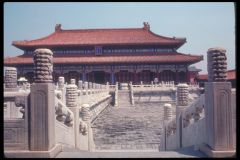
1) What is this?
2) What Dynasty/ time is it from? 3) What is it made of? 4) How was it used? |

1) An imperial throne called Taihe Dian, or "Hall of Supreme Harmony" used for over 2 dynasties, is a massive imposing structure 210 feet long and 108 feet deep. Built in the Ming Dynasty in 1627, rebuilt in 1697, and again in 1765
3) built of wood with a terrcotta tile roof and polychrome tile embellishments along the ridge of the roof 4)Served as a throne room and audience hall for 24 consecutive emperors of the Ming and Qing periods. It is the most imposing building in the center of the Forbidden City in Bejing. It's colors are red for luck and good fortune, gold is the color of imperial family |
The "Forbidden City" also called the Imperial Palace was very restricted. Only the imperial family, their advisors, and servants were allowed to enter its walls. Its position as the central building emphasizes the central position of the emperor.
|
|

1) What is this?
2) What Dynasty/ time is it from? 3) What is it made of? 4) How was it used? |

1) an enormous and elaborately decorated throne which was a symbol of authority.
2) Ch'ing (Quing) Dynasty Ch'ien-lung Period, 18th Century 3)Polychrome Lacquer over a soft wood frame. The lacquer is made of tree sap and is built up in layers and carved. Cinnabar colored lacquer is very popular. back and sides have dragons and medallions that symbolize imperial rule and long life. 4) The emperor sat on his throne to receive important members of the court as well as for exchanges with visitors. The throne was a symbol of authority and wealth and made the emperor seem superhuman. |
The use of an elaborate throne as a symbol of authority reflects the influence of practices in European courts. In addition the shape of the throne, with its curving cabriole legs was probably influenced by European examples.
|
|

1) What is this?
2) What Dynasty/ time is it from? 3) What is it made of? 4) How was it used? |
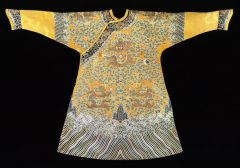
1) A beautiful embroidered robe called "Empress's 12- Symbol Robe"
2) Ch'ing (Quing) Dynasty Ch'ien-lung Period, 18-19 Century 3) yellow satin, embroidered with colors of silk and gold threads with a central 5-clawed dragon surrounded by other dragons (5 clawed dragon was a symbol for the Imperial family) neckline has decorations of 12 Imperial symbols 4) Only the Imperial family and other very significant people would have worn such robes so they served as important symbols of status. |
This robe also has stylized clouds and flaming pearls which are also depicted on the Imperial throne. Textiles have been somewhat neglected by scholars so we do not know much about the textile workshops that existed or about individual artists that served the imperial courts.
|
|
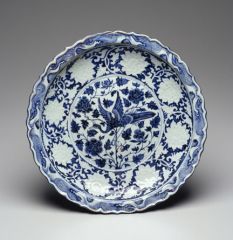
1) What is this?
2) What Dynasty/ time is it from? 3) What is it made of? 4) How was it used? |

1) This is a blue and white dish decorated with painting executed in blue underglaze. Decoration is organized in 3 concentric rings with a large peacock in the center surrounded by symmetrical stylized flowers.
2) Yaun Dynasty 14th century 3) molded porcelain with blue underglaze; Ching-te-chen ware 4) Plate was produced for sale to the Middle Easter market. Clues that show this are its larger size, blue color and peacocks were not popular in the Yuan period dynasty but were common and popular in the Middle East. |
Porcelain is made of fine white clay fired at extremely high temperatures. During the Yuan Dynasty it was unique to China and so porcelain objects were highly desirable in foreign markets. Using a mold made them easier to produce in quantity.
|
|

1) What is this?
2) What Dynasty/ time is it from? 3) What is it made of? 4) How was it used? |

1) This is a decorated pillow that has images that illustrate the Seven Sages of the Bamboo Grove. 7 sages are lined up in a row and move towards a grove of bamboo. There is a boarder of abstracted floral motif.
2) Sung-Chin (Song-Jin) Dynasty 12-13 Century, Li Family Workshop 3)Made of Stoneware (earthenware) decorated with brown iron pigments, then glazed with transparent glaze and fired 4) pillows were often produced by workshops and sold at market. Cizhou is a region known for its kilns and its pillows |
Bamboo was representative of the gentlemanly ideal, as it possesses the ability to stand firm, while simultaneously maintaining flexibility. The 7 sages were believed to have lived in the Luoyang region soon after the downfall of the Han Dynasty. They represent ideal men and scholars who retreat from society to devote themselves to their studies. They represent a Daoist ideal because they withdrew from society in order to convene with nature.
|
|

1) What is this?
2) What Dynasty/ time is it from? 3) What is it made of? 4) How was it used? |

1) this is an 'Official Seal' seal topped with a figurative representation of a tortoise. On the underside is the seal itself.
2) Han Dynasty, 2nd century 3) Made of gilt bronze likely using the bronze lost wax casting method where a wax model is carved then encased in a clay shell and allowed to harden. Then the clay is heated, the wax melts and drains out and molten bronze is poured in. 4) Seals are used mostly by those who worked with the written word- officials,scholars, merchants, to mark a document much like a signature or it could also mark an object. |
By the Han Dynasty seals were made in a variety of materials such as jade, soapstone, gold, turquoise and bronze. a tortoise could of been chosen by its owner because it is a sign of wisdom.
|
|

1) What is this?
2) What Dynasty/ time is it from? 3) What is it made of? 4) How was it used? |
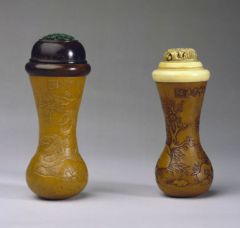
1) These 2 gourds are used as containers to hold crickets. Collecting crickets was a hobby that was popular especially among scholars. This tradition came down from the Tang dynasty.
2) Ch'ing (Qing) Dynasty, 17th Century 3) They are made of hollowed out gourds decorated with landscape scenes incised using a heating implement. The caps are carved of tortoise shell and ivory. 4) Owners of crickets desired to remain close to nature and listening to and reflecting on the quiet sounds of a cricket was a way to gain contact with the natural world. |
Collectors of crickets used both summer (bamboo) and winter (gourd) containers (ceramic was also used). They also used 'cricket ticklers' to produce desired chirping sounds.
|
|
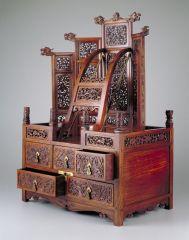
1) What is this?
2) What Dynasty/ time is it from? 3) What is it made of? 4) How was it used? |

1) This is a large and elegant "Cosmetic case and Mirror Stand" embellished with dragon heads (male energy/emperor) on the corners of each panel and with panels of phoenixes (female energy/empress) amongst clouds.
2) Ming Dynasty, early 17th century 3) Used by a member of the ruling class as a mirror stand and to hold cosmetics and hairpins. The amount of work that went into its creation demonstrates the great concentration of wealth in the hands of the most elite members of society. |
The elaborate carving illustrated the style of furnishings and decorative arts popular during the Ming dynasty.
|

